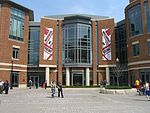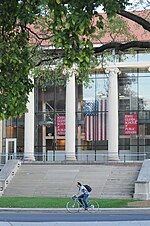Summit on 16th United Methodist Church
Endangered buildings in Columbus, OhioFormer churches in OhioUniversity District (Columbus, Ohio)
Summit on 16th United Methodist Church is a former church in Columbus, Ohio. The building was constructed in 1954, originally for the Wesley Foundation of the Ohio State University. In 1977, the foundation merged with the Indianola United Methodist Church and University United Methodist Church to form the Summit United Methodist Church. The building was listed on Columbus Landmarks' 2023 Most Endangered Sites list, as plans were released to demolish the church and replace it with a seven-story apartment building.In 1983, mid-century architect Edward Sövik redesigned the building's multi-purpose room to create a worship space for the congregation.
Excerpt from the Wikipedia article Summit on 16th United Methodist Church (License: CC BY-SA 3.0, Authors).Summit on 16th United Methodist Church
Waldeck Avenue, Columbus
Geographical coordinates (GPS) Address Nearby Places Show on map
Geographical coordinates (GPS)
| Latitude | Longitude |
|---|---|
| N 40.001388888889 ° | E -83.005833333333 ° |
Address
Summit on 16th United Methodist Church
Waldeck Avenue
43201 Columbus
Ohio, United States
Open on Google Maps










